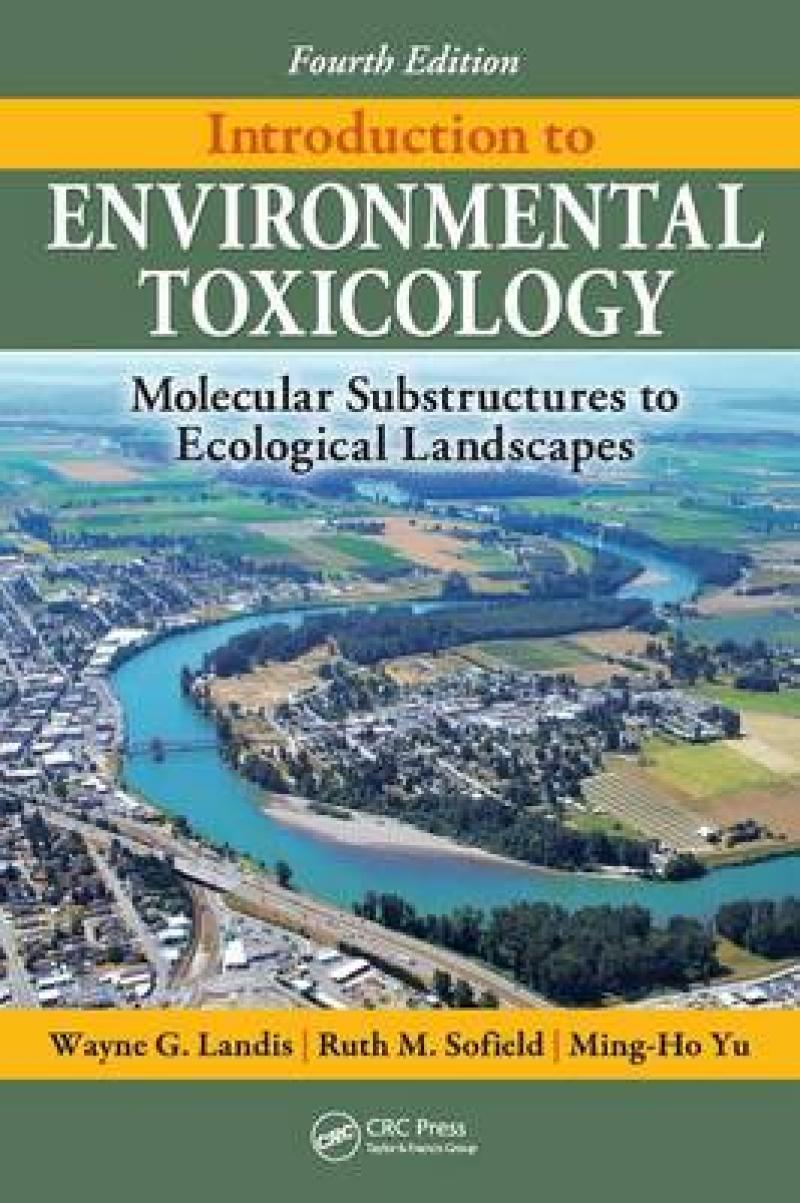After fifteen years and three editions, Introduction to Environmental Toxicology: Molecular Substructures to Ecological Landscapes has become a standard that defines the field of environmental toxicology, and the fourth edition is no exception. The authors take an integrated approach to environmental toxicology that emphasizes scale and context as important factors in understanding effects and management options.
New in the Fourth Edition:
New author, Dr. Ruth M. Sofield8-page color insertNew chapter on fate and transport of contaminantsEmphasis on the use of all types of models in understanding how nature worksRevised sections on synergy and atrazine toxicityUpdated coverage of the analysis of impacts to populations, communities and ecosystemsEnlarged risk assessment chapter with an in-depth description of a regional scale risk assessment
This edition benefits from the insight of a new author, Dr. Ruth M. Sofield, who prepared the new chapter on the fate and transport of contaminants. The relationship between structure and toxicological properties has been a major theme of this book since its inception and this new chapter expands this fundamental concept to include fate and transport. In the early chapters the use of models in science is discussed and this theme carries throughout the rest of the book.
So much has changed in the fifteen years since the publication of the first edition. The mid-1990s seem so long ago, when our understanding of environmental toxicology was very basic. Ecological risk assessment was in its very early stages and the consideration of the effects of toxicants on landscapes was only beginning. Computation was still hard, genes stayed put, and it was only becoming recognized that xenobiotics could have hormonal effects - developments that are taken for granted in this edition. Written by authors who teach this subject, a feature that is reflected in their straightforward style, the book provides a foundation for understanding environmental toxicology and its application.
Les mer
Defines the field of environmental toxicology. This book provides an integrated approach to understanding environmental toxicology that emphasizes scale and context as important factors in understanding effects and management options. It includes a chapter on fate and transport.
Les mer
Introduction to Environmental ToxicologyEnvironmental Toxicology as an Interdisciplinary ScienceA Brief History and Organizations in Environmental ToxicologyInteractions and Connections of Environmental Toxicology to the Management of Ecological SystemsLegislationIntroduction to This TextbookStudy QuestionsFrameworks and Paradigms for Environmental ToxicologyThe FundamentalsModelsFundamental Models for Environmental ToxicologyThe Classical Viewpoint for Classifying Toxicological EffectsChemical Physical-Chemical CharacteristicsBioaccumulation/Biotransformation/BiodegradationReceptors and the Mode of ActionBiochemical and Molecular EffectsPhysiological and Behavioral EffectsPopulation ParametersCommunity EffectsEcosystem EffectsAn Alternative Framework Incorporating Complexity TheorySpatial and Temporal ScalesCombining Scale and Ecological Dynamics: The Hierarchical Patch Dynamic ParadigmStrategy and Tactics in the Use of Models in Environmental ToxicologyStudy QuestionsReferences and Suggested ReadingsAn Introduction to Toxicity TestingIntroductionThe Dose-Responsive CurveThresholds and HormesisTerminology Based upon Hypothesis TestingClassification of Toxicity TestsDesign Parameters for Single-Species Toxicity TestsLimitations and Alternatives to Hypothesis TestingCommonly Used Methods for the Calculation of EndpointsComparison of Calculations of Several Programs for Calculating Probit AnalysisHypothesis TestingCurve Fitting and Regression Modeling versus Hypothesis TestingThe Design of Multispecies Toxicity TestsUnivariate MethodsMultivariate MethodsVisualizationSummary of Design Guidelines for Multispecies Toxicity TestsStandard MethodsStudy QuestionsReferences and Suggested ReadingsSurvey and Review of Typical Toxicity Test MethodsIntroductionAnimal Care and Use ConsiderationsSingle-Species Toxicity TestsMultispecies Toxicity TestsSummaryStudy QuestionsAppendix 4.1: The Natural History and Utilization of Selected Test SpeciesThe Fate and Transport of ContaminantsIntroductionTransport MechanismsPersistenceBiotransportAbiotic Degradation/TransformationMultimedia Box ModelsEquilibriumThe Fugacity ApproachBioconcentration versus BiomagnificationBioavailabilitySummaryStudy QuestionsReferences and Suggested ReadingsUptake and Modes of ActionThe Damage ProcessAtmospheric Pollutants and PlantsMechanisms of ActionSpecific Modes of Action in DetailReceptor-Mediated Toxicity, Endocrine DisruptionIntroduction to QSARStudy QuestionsReferences and Suggested ReadingsFactors Modifying the Activity of ToxicantsIntroductionPhysicochemical Properties of PollutantsTime and Mode of ExposureEnvironmental FactorsInteraction of PollutantsToxicity of MixturesBiological Factors Affecting ToxicityStudy QuestionsReferences and Suggested ReadingsInorganic Gaseous PollutantsSulfur OxidesNitrogen OxidesOzoneCarbon MonoxideStudy QuestionsReferences and Suggested ReadingsFluoride as a Contaminant of Developing EconomiesEnvironmental Sources and Forms of FluorideIndustrial Sources of Fluoride PollutionEffect on PlantsEffect on AnimalsEffect on Human HealthBiochemical EffectStudy QuestionsReferences and Suggested ReadingsHeavy MetalsIntroductionLeadCadmiumMercuryStudy QuestionsReferences and Suggested ReadingsBiotransformation, Detoxification, and BiodegradationIntroductionMetabolism of Environmental Chemicals: BiotransformationTypes of BiotransformationMechanisms of BiotransformationConsequences of BiotransformationMicrobial DegradationBioremediationAn Example of a Detoxification Enzyme: The Organophosphate Acid (OPA) AnhydrolasesStudy QuestionsReferences and Suggested ReadingsEcological Effects from Biomarkers to PopulationsIntroductionTerminology and ContextThe Key to Context: The Hierarchical Patch Dynamics ParadigmMeasurement of Ecological Effects at Various Scales or Levels of Biological OrganizationBioaccumulation/Biotransformation/BiodegradationMolecular and Physiological Indicators of Chemical Stress BiomarkersAssemblage and Community ParametersEffects at the Population ScaleInteracting Populations in a Patchy EnvironmentThe Importance of Patch DynamicsImplicationsAppendix: Age-Structured Population Modeling in DetailStudy QuestionsReferences and Suggested ReadingsEcological Effects: Community to Landscape Scales of Toxicological ImpactsIntroductionCommunity EffectsEffects on Ecosystems or Ecological StructuresApplication of Multivariate TechniquesPollution-Induced Community ToleranceInterpretation of Ecosystem Level ImpactsAn Alternative Model: The Community Conditioning HypothesisThe Design of Field StudiesMaking DecisionsAppendix: Multivariate Techniques-Nonmetric ClusteringStudy QuestionsReferences and Suggested ReadingsEcological Risk AssessmentIntroductionBasics of Risk AssessmentEcological Risk AssessmentEcological Risk Assessment FrameworkRisk CharacterizationTechniques in Ecological Risk AssessmentStudy QuestionsReferences and Suggested ReadingsAppendix A: References for Toxicity Testing and Interpretation, Compiled by April J. MarkiewiczIndex
Les mer
Praise for the Second Edition:"Buy the book, read it, and learn from it. This book genuinely helps to unify and clarify the ecotoxicology field, and as such joins a select few titles bringing coherence to a complex scientific arena. I hope that the authors will keep carefully revised and updated editions in circulation for many years to come."-P.G. Wells, Environmental Conservation Branch, Environment Canada, in Ecotoxicology, Vol. 9, No.3
Les mer
Produktdetaljer
ISBN
9781439804100
Publisert
2011-01-07
Utgave
4. utgave
Utgiver
Vendor
CRC Press Inc
Vekt
1179 gr
Høyde
254 mm
Bredde
178 mm
Aldersnivå
06, 05, P, U
Språk
Product language
Engelsk
Format
Product format
Innbundet
Antall sider
542
